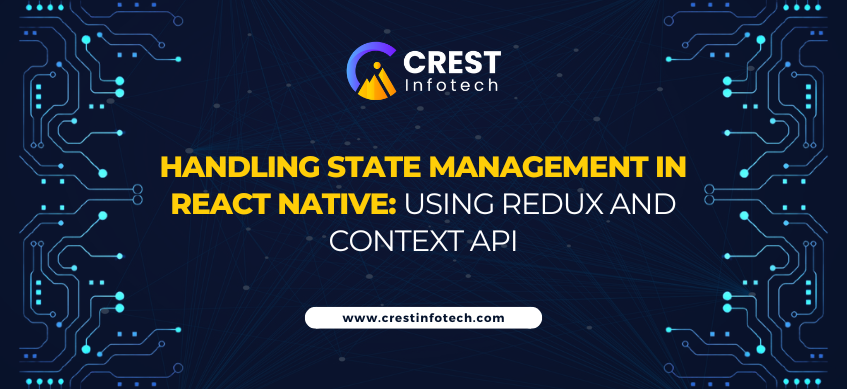State management is a fundamental concept in building React Native applications. As your app grows in complexity, managing state across various components becomes challenging. React provides several tools for managing state, with Redux and the Context API being two of the most popular choices.
In this article, we’ll explore how to handle state management in React Native using Redux and the Context API. We’ll cover their differences, benefits, and practical implementation to help you choose the right solution for your app.
1. Introduction to State Management
In React Native, the state refers to data that determines how a component renders and behaves. State management is the process of handling this data across different components in your app.
While React provides local state management using the useState hook for functional components, this can become cumbersome when the app grows, and multiple components need access to the same state. This is where global state management solutions like Redux and the Context API come into play.
2. The Redux Approach to State Management
What is Redux?
Redux is a popular state management library that provides a centralized store for managing your app’s state. It allows all components of an application to share the same state, making it easier to manage complex state interactions and avoid prop drilling (passing props through multiple layers of components).
Redux follows three fundamental principles:
- Single Source of Truth: The state of your app is stored in a single, immutable store.
- State is Read-Only: The only way to change the state is by dispatching actions.
- Changes are Made with Pure Functions: A reducer function handles the state transitions.
Setting Up Redux in a React Native App
1. Install Redux and React-Redux:
To get started with Redux, you need to install redux and react-redux libraries.
npm install redux react-redux
2. Create Redux Store:
Create a store.js file to define your Redux store and reducers.
import { createStore } from 'redux';
// Define initial state
const initialState = {
counter: 0,
};
// Define action types
const INCREMENT = 'INCREMENT';
const DECREMENT = 'DECREMENT';
// Define the reducer
const counterReducer = (state = initialState, action) => {
switch (action.type) {
case INCREMENT:
return { ...state, counter: state.counter + 1 };
case DECREMENT:
return { ...state, counter: state.counter - 1 };
default:
return state;
}
};
// Create the store
const store = createStore(counterReducer);
export default store;
3. Set up Provider in App:
Now, wrap your app with Provider from react-redux to provide the Redux store to your components.
import React from 'react';
import { Provider } from 'react-redux';
import { View, Text, Button } from 'react-native';
import store from './store';
const App = () => {
return (
<Provider store={store}>
<Counter />
</Provider>
);
};
const Counter = () => {
// Use dispatch to update state
return (
<View>
<Text>Counter</Text>
<Button title="Increment" onPress={() => console.log('Incremented')} />
</View>
);
};
export default App;
4. Connecting Redux State to Components:
Use the useSelector hook to access the state and useDispatch hook to dispatch actions in your components.
import React from 'react';
import { View, Text, Button } from 'react-native';
import { useSelector, useDispatch } from 'react-redux';
const Counter = () => {
const counter = useSelector(state => state.counter); // Access state
const dispatch = useDispatch(); // Dispatch actions
const increment = () => dispatch({ type: 'INCREMENT' });
const decrement = () => dispatch({ type: 'DECREMENT' });
return (
<View>
<Text>Counter: {counter}</Text>
<Button title="Increment" onPress={increment} />
<Button title="Decrement" onPress={decrement} />
</View>
);
};
export default Counter;
3. The Context API Approach to State Management
What is the Context API?
The Context API is a built-in solution provided by React for managing global state without needing external libraries like Redux. It’s useful for apps that need a simple, lightweight solution to avoid prop drilling, where state needs to be passed down several layers of components.
Unlike Redux, which is optimized for large-scale applications, the Context API is typically used for smaller applications or where state management doesn’t need to be complex.
Using the Context API in React Native
1. Create a Context:
Start by creating a context and a provider component.
import React, { createContext, useState } from 'react';
// Create a Context
export const CounterContext = createContext();
// Create a Provider component
export const CounterProvider = ({ children }) => {
const [counter, setCounter] = useState(0);
const increment = () => setCounter(counter + 1);
const decrement = () => setCounter(counter - 1);
return (
<CounterContext.Provider value={{ counter, increment, decrement }}>
{children}
</CounterContext.Provider>
);
};
2. Wrap Your App with the Provider:
Wrap your entire app (or part of it) with the CounterProvider to provide the global state to components.
import React from 'react';
import { CounterProvider } from './CounterContext';
import Counter from './Counter';
const App = () => {
return (
<CounterProvider>
<Counter />
</CounterProvider>
);
};
export default App;
3. Accessing State in Components:
Use the useContext hook to access the state within components.
import React, { useContext } from 'react';
import { View, Text, Button } from 'react-native';
import { CounterContext } from './CounterContext';
const Counter = () => {
const { counter, increment, decrement } = useContext(CounterContext);
return (
<View>
<Text>Counter: {counter}</Text>
<Button title="Increment" onPress={increment} />
<Button title="Decrement" onPress={decrement} />
</View>
);
};
export default Counter;
4. Redux vs. Context API
When to Use Redux:
- Large Applications: Redux is ideal for large-scale applications with complex state management needs, where multiple components depend on the same state.
- Advanced Features: Redux offers advanced features like middleware (e.g., for logging or handling asynchronous actions), which the Context API does not have.
- Performance Optimization: Redux is highly optimized for performance in large apps, especially when dealing with complex state transitions.
When to Use Context API:
- Small to Medium Apps: If your app’s state management needs are relatively simple and don’t require advanced features, the Context API can be a more lightweight and easier solution.
- Avoiding Third-Party Libraries: The Context API is built into React, so you don’t need to install or configure any external libraries.
5. Conclusion
Both Redux and the Context API are powerful tools for handling state management in React Native apps. The choice between the two depends on the complexity of your app and the scale of your state management needs.
- Use Redux when building larger applications that require complex state management, performance optimizations, and advanced features.
- Use the Context API for smaller apps or when you need a simple solution for sharing state across components without introducing additional complexity.
By choosing the right state management solution for your app, you can keep your codebase clean, maintainable, and efficient, ensuring a smooth development process as your app grows.



